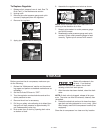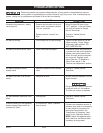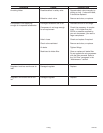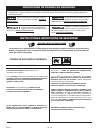
TROUBLESHOOTING
Performing repairs may expose voltage sources, moving parts or compressed air sources,
moving parts or compressed air sources. Personal injury may occur. Prior to attempting any
repairs, unplug the air compressor and bleed off all air tank air pressure.
PROBLEM
CAUSE
CORRECTION
Pressure switch does not shut off
motor when compressor reaches
“cut-out” pressure.
Pressure switch “cut-out” too
high.
Move On/Auto/Off lever to the
“OFF” position, if the outfit does
not shut off contact a Trained
Service Technician.
Contact a Trained Service
Technician.
Excessive tank pressure - safety
valve pops off.
Tube fittings are not tight enough. Tighten fittings where air can be
heard escaping. Check fittings
with soapy water solution. DO
NOT OVERTIGHTEN.
Air leaks at fittings.
Air leaks at pressure switch
release valve.
Defective pressure switch release
valve.
Contact a Trained Service
Technician.
Air leaks in air tank or at air tank
welds.
Defective air tank. Air tank must be replaced. Do not
repair the leak.
Do not drill into, weld or otherwise
modify air tank or it will weaken.
The tank can rupture or explode.
Air leaks between head and valve
plate.
Leaking seal. Contact a Trained Service
Technician.
Air leaks at or inside check valve
Check valve seat damaged.
Pressure reading on the regulated
pressure gauge drops when an
accessory is used.
It is normal for “some” pressure
drop to occur.
If there is an excessive amount of
pressure drop when the accessory
is used, adjust the regulator fol-
lowing the instructions in the
“Description of Operation” para-
graph in the “Operation Section.
NOTE: Adjust the regulated pres-
sure under flow conditions (while
accessory is being used).
16-EngD22130
A defective check valve results in
a constant air leak at the pressure
release valve when there is pres-
sure in the tank and the compres-
sor is shut off. Replace check
valve. Refer the “To Replace or
Clean Check Valve” in the
"Service and Adjustment" section.


















